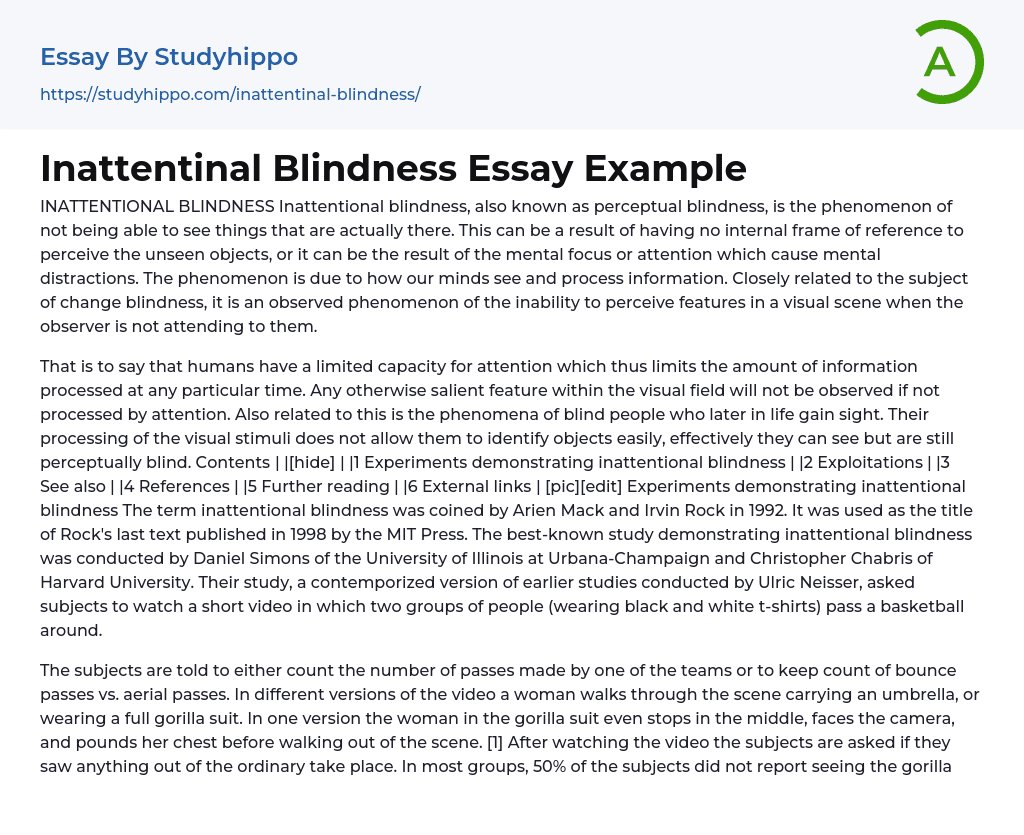

Inattentional Blindness, Also Known as Perceptual Blindness Essay Example
Inattentional blindness is the phenomenon of not being able to see things that are actually there. This can be a result of having no internal frame of reference to perceive the unseen objects, or it can be the result of the mental focus or attention which cause mental distractions. The phenomenon is due to how our minds see and process information. Closely related to the subject of change blindness, it is an observed phenomenon of the inability to perceive features in a visual scene when the observer is not attending to them.
That is to say that humans have a limited capacity for attention which thus limits the amount of information processed at any particular time. Any otherwise salient feature within the visual field will not be observed if not processed by attention. Also related to this is the phenomena of blind pe
...ople who later in life gain sight. Their processing of the visual stimuli does not allow them to identify objects easily, effectively they can see but are still perceptually blind.
The term inattentional blindness was coined by Arien Mack and Irvin Rock in 1992. It was used as the title of Rock's last text published in 1998 by the MIT Press. The best-known study demonstrating inattentional blindness was conducted by Daniel Simons of the University of Illinois at Urbana-Champaign and Christopher Chabris of Harvard University. Their study, a contemporized version of earlier studies conducted by Ulric Neisser, asked subjects to watch a short video in which two groups of people (wearing black and white t-shirts) pass a basketball around.
The subjects are told to either count the number of passes made by one of the teams
or to keep count of bounce passes vs. aerial passes. In different versions of the video a woman walks through the scene carrying an umbrella, or wearing a full gorilla suit. In one version the woman in the gorilla suit even stops in the middle, faces the camera, and pounds her chest before walking out of the scene. [1] After watching the video the subjects are asked if they saw anything out of the ordinary take place. In most groups, 50% of the subjects did not report seeing the gorilla. Simons interprets this by stating that people are mistaken with regard to how important events will automatically draw their attention away from current tasks or goals.
This result indicates that the relationship between what is in one's visual field and perception is based much more significantly on attention than was previously thought. Another experiment was carried out by Steve Most, Daniel Simons, Christopher Chabris, and Brian Scholl. They had objects moving randomly on a computer screen. Participants were instructed to attend to the black objects and ignore the white, or vice versa. After several trials, a red cross unexpectedly appeared and traveled across the display, remaining on the computer screen for five seconds. The results of the experiment showed that even though the cross was distinctive from the black and white objects both in color and shape, about a third of participants missed it.
They had found that people may be attentionally tuned to certain perceptual dimensions, such as brightness or shape. NASA conducted an experiment in a flight simulator in which commercial pilots were tested to see if they would notice distractions on a runway during
simulated landings. Those who were trained pilots did not notice and landed directly on top of the distraction 1/4 of the time, while untrained pilots didn't know what to expect of a typical landing and thus saw the distraction.
Exploitations Inattentional blindness is exploited by illusionists in the presentation of "magic shows" in the performance of some tricks by focusing the udience attention upon some distractive element, away from elements of the scene under manipulation by the performer. This is called misdirection amongst magicians.
A good example is Derren Brown who repeats several of the original change blindness experiments, including the person change trick, where someone is asked to give directions to a 'lost' tourist clutching a map (conducted by Daniel Simons and Daniel Levin). Something like a door or a large object is passed between them by some workmen. When the door or object has gone past, the person who is asking for directions and clutching the map has changed. In the original experiments, about 50% of people didn't notice this.
- Resilience essays
- Intelligence essays
- Problem Solving essays
- Perception essays
- Consciousness essays
- Mindset essays
- Nightclub essays
- Factory essays
- Material essays
- Production And Manufacturing essays
- Alarm clock essays
- Central Nervous System essays
- Age Of Enlightenment essays
- Ethos essays
- Time essays
- Acceptance essays
- Meaning Of Life essays
- Reality essays
- Natural Law essays
- Political Philosophy essays
- Utilitarianism essays
- Existence essays
- Free Will essays
- Good And Evil essays
- Confucianism essays
- Relativism essays
- Conscience essays
- Environmentalism essays
- Empiricism essays
- Epistemology essays
- Ethics essays
- Existentialism essays
- Human Nature essays
- Individualism essays
- Metaphysics essays
- Philosophy Of Life essays
- Transcendentalism essays
- Truth essays
- Destiny essays
- Determinism essays
- Fate essays
- Functionalism essays
- Philosophers essays
- Pragmatism essays
- Future essays
- Child Observation essays
- Critical Reflection essays
- Teaching Philosophy essays
- Personal Philosophy essays
- Action Speak Louder Than Words essays



